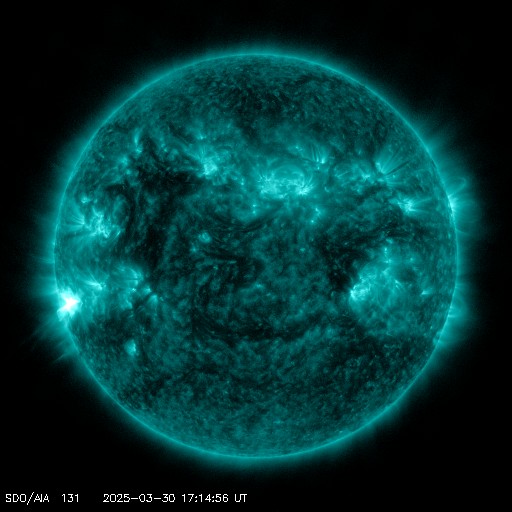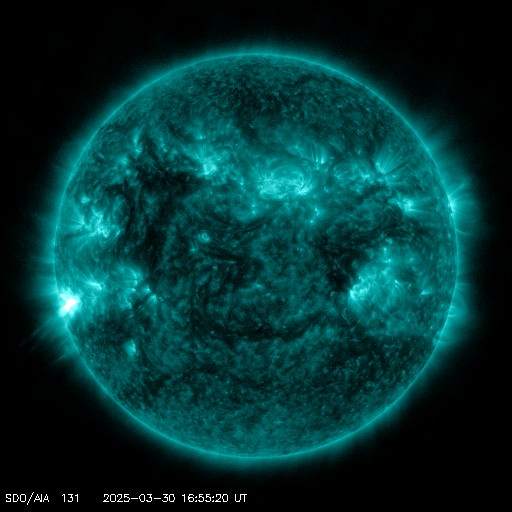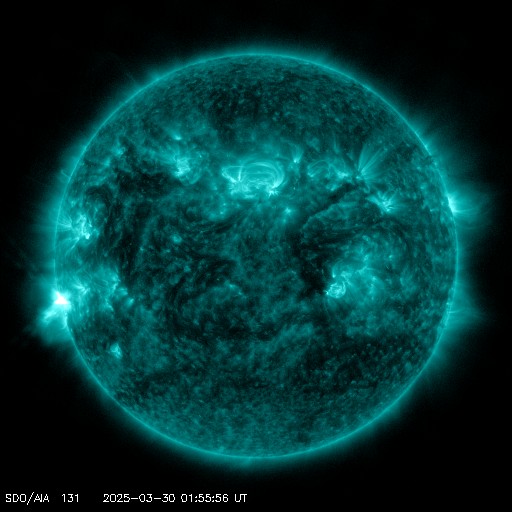Viewing archive of Thursday, 14 July 2005
Solar activity report
Any mentioned solar flare in this report has a scaling factor applied by the Space Weather Prediction Center (SWPC). Because of the SWPC scaling factor, solar flares are reported as 42% smaller than for the science quality data. The scaling factor has been removed from our archived solar flare data to reflect the true physical units.
Report of Solar-Geophysical Activity 2005 Jul 14 2210 UTC# Prepared jointly by the U.S. Dept. of Commerce, NOAA, #Space Environment Center and the U.S. Air Force. #
Joint USAF/NOAA Report of Solar and Geophysical Activity
SDF Number 195 Issued at 2200Z on 14 Jul 2005IA. Analysis of Solar Active Regions and Activity from 13-2100Z to 14-2100Z
Solar activity was at high levels this period. Region
786 (N12W97) continues to be very active as it rotates around the
west limb. Two major events occurred from this region today. The
first was an M9 x-ray event with a 220 sfu Tenflare at 14/0725Z. A
CME was observed on LASCO imagery in association with this event. A
considerably more powerful, long duration X1 proton flare occurred
at 14/1055Z. Strong radio emissions accompanied this flare including
a 3400 sfu Tenflare, a 120,000 sfu burst at 610 MHz, and a Type IV
radio sweep. A very bright and fast (approximately 1430 km/s) halo
CME was observed on LASCO imagery. The remainder of the solar disk
and limb was quiet.
IB. Solar Activity Forecast
Solar activity is expected to be
moderate, although there is still a chance for another major flare
from Region 786 as it rotates around the west limb. Low to very low
conditions are expected on 16 and 17 July.
IIA. Geophysical Activity Summary 13-2100Z to 14-2100Z
The geomagnetic field was quiet to active. Solar wind speed remains
elevated near 500 km/s, but is declining. The most disturbed
geomagnetic periods occurred between 14/0100 - 1300Z when the IMF Bz
was predominantly southward. A slow, gradual rise in the greater
than 10 MeV protons began soon after yesterday's M5 event. The 10
pfu alert threshold was finally reached at 14/0245Z. A second,
larger influx of high energy protons followed today's X1 flare. The
greater than 10 MeV proton flux were still slowly increasing at
issue time, and the peak flux so far is 53 pfu at 14/1905Z. The
greater than 2 MeV electron flux was at high levels again today.
IIB. Geophysical Activity Forecast
The geomagnetic field is
expected to range from quiet to minor storm levels over the next
three days. Occasional major storm periods are possible at high
latitudes. At least three CMEs from the M1, M5, and X1 events on 12,
13, and 14 July respectively, are expected to generate the storm
periods. The greater than 10 MeV proton event currently in progress
is expected to continue through 15 July. Assuming no new injection
of particles, this event will likely end by 16 July.
III. Event Probabilities 15 Jul to 17 Jul
| Class M | 50% | 20% | 10% |
| Class X | 10% | 01% | 01% |
| Proton | 20% | 10% | 05% |
| PCAF | In Progress | ||
IV. Penticton 10.7 cm Flux
Observed 14 Jul 090 Predicted 15 Jul-17 Jul 085/080/080 90 Day Mean 14 Jul 097
V. Geomagnetic A Indices
Observed Afr/Ap 13 Jul 020/030 Estimated Afr/Ap 14 Jul 010/015 Predicted Afr/Ap 15 Jul-17 Jul 025/025-025/025-015/020
VI. Geomagnetic Activity Probabilities 15 Jul to 17 Jul
| A. Middle Latitudes | |||
|---|---|---|---|
| Active | 50% | 50% | 40% |
| Minor storm | 30% | 30% | 20% |
| Major-severe storm | 10% | 10% | 05% |
| B. High Latitudes | |||
|---|---|---|---|
| Active | 45% | 45% | 40% |
| Minor storm | 35% | 35% | 25% |
| Major-severe storm | 20% | 20% | 10% |
All times in UTC
Current data suggests there is a slight possibility for aurora to appear at the following high latitude regions in the near future
Norilsk, VorkutaLatest news
Latest forum messages
More topicsSupport SpaceWeatherLive.com!
A lot of people come to SpaceWeatherLive to follow the Sun's activity or if there is aurora to be seen, but with more traffic comes higher server costs. Consider a donation if you enjoy SpaceWeatherLive so we can keep the website online!

Latest alerts
17:27 UTC - Solar flare
Moderate M1.5 flare
17:03 UTC - Solar flare
Moderate M1.61 flare
16:45 UTC - Radio Blackout
Minor R1 radio blackout in progress (≥M1 - current: M1.61)
02:09 UTC - Solar flare
Moderate M1.54 flare from sunspot region 4048
01:42 UTC - Radio Blackout
Minor R1 radio blackout in progress (≥M1 - current: M1.24)
Space weather facts
| Last X-flare | 2025/03/28 | X1.1 |
| Last M-flare | 2025/03/30 | M1.4 |
| Last geomagnetic storm | 2025/03/27 | Kp5 (G1) |
| Spotless days | |
|---|---|
| Last spotless day | 2022/06/08 |
| Monthly mean Sunspot Number | |
|---|---|
| February 2025 | 154.6 +17.6 |
| March 2025 | 127.5 -27.1 |
| Last 30 days | 127.5 -24.7 |





